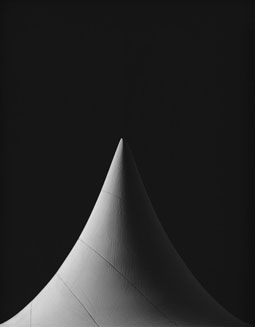 |
 |
Mathematical Form: Surface, 0009, 2004
Gelatin silver print
149.2 x 119.4 cm
© Hiroshi Sugimoto / Courtesy of Gallery Koyanagi |
 |
There is a great deal of similarity and contrast between Hiroshi Sugimoto's "Architecture" and "Conceptual Forms" series that lends an attractive conceptual play to the exhibition "Various Archetypes" at The National Museum of Art, Osaka. Apparently he used the same camera for both, and the works are all the same size, the large-format black and white photographic prints Sugimoto has made his signature.
But there is also the discrepancy in size between the small-scale mathematical model subject matter of "Conceptual Forms" posed against the monumental works of Modernist building in "Architecture." Perhaps the most startling visual qualities are the descriptive sharpness of the former, and painterly blur in the latter.
In the "Architecture" series, Sugimoto took pictures of buildings by revered hard-edged Modernist architects. But he did so in such a way as to set the focus at "double infinity," so that the image is intentionally inexact, as a technical requirement and as an "effect" that characterizes the series. The image is thus emptied of the most specific information, and hard-edged linearity abandoned. The result is that what will be captured as an image is made to submit to the subtlety of the technical circumstances the camera is placed in, although the compositional role remains Sugimoto's. This becomes particularly clear when observing whether the photograph is a building exterior shot, as in "Guggenheim Museum, NY (Frank Lloyd Wright)" (1997/2001), or an interior, such as "Woodland Chapel (Erik Gunnar Asplund)" (2001). And it becomes even more insistent in a work such as "Church of the Light (Tadao Ando)" (1997/2001), where a grand Russian Formalist-style cross of light quarters the picture, illuminating the site as a spiritual abode.
The blur also means that while the architectural subject is present, it is not entirely visible, and indicates that borrowing the forms of iconic architecture is only partly citation. Distorting the appearance of the architectural subject in this way refers the spectator back to Sugimoto's photographic artistry, giving an originality of image partly independent of architectural reference. Hence Sugimoto can say, "people who go to see the real thing after seeing my photos are invariably disappointed." The intentional flawing of the photographic scene creates a kind of threshold that inhibits an impulse to intimacy and familiarity with the structures themselves.
The diffusive sfumato of solid forms in "Architecture" comes about turn in "Conceptual Forms" where the normally non-visual is captured with the utmost attentiveness and precision. Mathematical formulas are conventionally of the most abstract conceptual kind, and usually do without form or substance in any concrete sense. However, Sugimoto's models were imported from Germany by Tokyo University in the 1910s and 1920s, and their curved surfaces are the result of mathematical formulas that, once data has been run through them, yield a series of points that ultimately produce the shape. Further geometrical elaboration comes in the title of each work, which, in contrast to the extreme economy of the visual image, tends toward descriptive virtuosity. A representative example is "Mathematical Form: Surface 0003, Dini's Surface: a surface of constant negative curvature obtained by twisting a pseudosphere" (2004).
The camera also captures the minutiae of the little objects, whether they are incisions presumably from the lathe that turned them, the seemingly more purposeful scoring of the object's surface, or the incidental chipping of too fine an edge. Here, in contrast to the "Architecture" series, the line of the contour is perfectly restituted. And here also, clarity and precision lend to only the most abstract identification of what these objects are.
One further series, represented by a solo image, rounds out the twelve pieces that comprise the show. A single image from a different series is in itself a kind of poverty, but the work "William Shakespeare" (1999), from the "Portrait" series, for which Sugimoto photographed the wax historical figures at Madame Tussauds, conjures a particular explanatory force for the exhibition as a whole.
An early irrational fear of portrait photography was that the act of having your picture taken would result in it also stealing your soul, and Sugimoto has spoken before of a peculiarly close concern relating to his "Architecture" series. "Buildings are the graves of architecture. Sometimes when the focus point for these architectural graves is double infinity, the soul of the dead architecture is captured, not quite able to die." The materialization of abstract mathematical formulas in concrete visual terms in the "Conceptual Forms" series is further suggestive, and indicates how the artist, who also designed the present exhibition, would like viewers to engage his work at this showing.
|